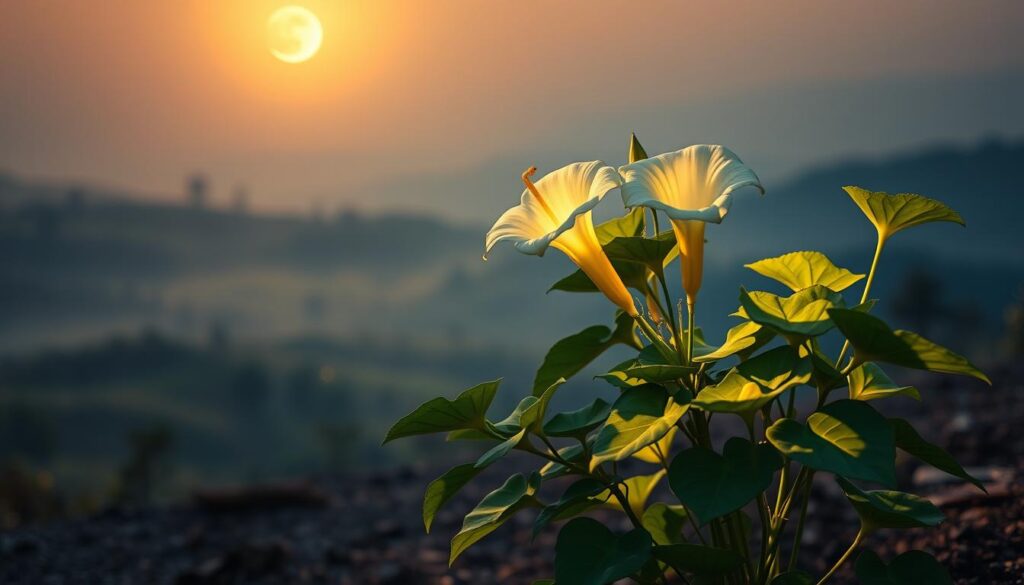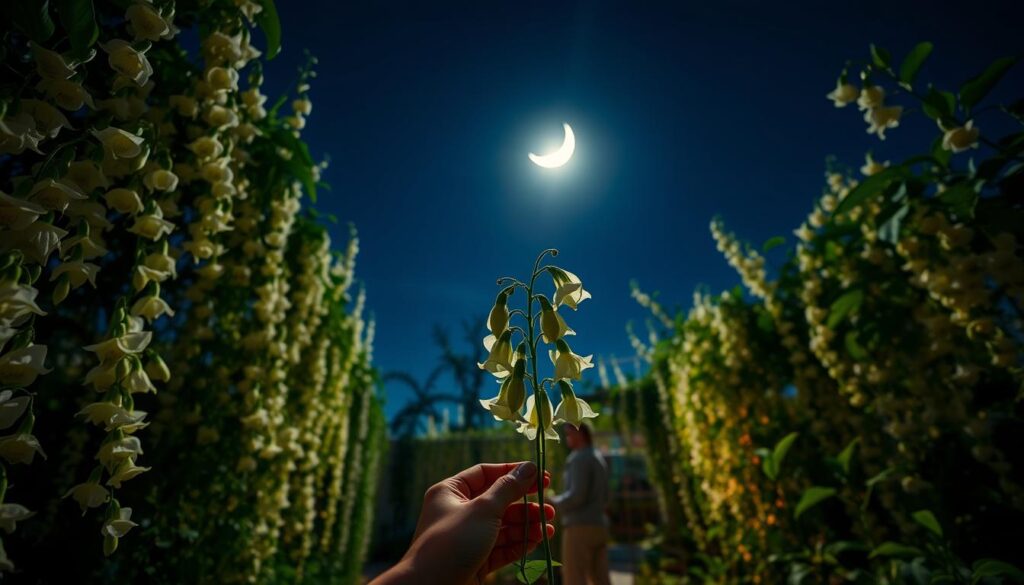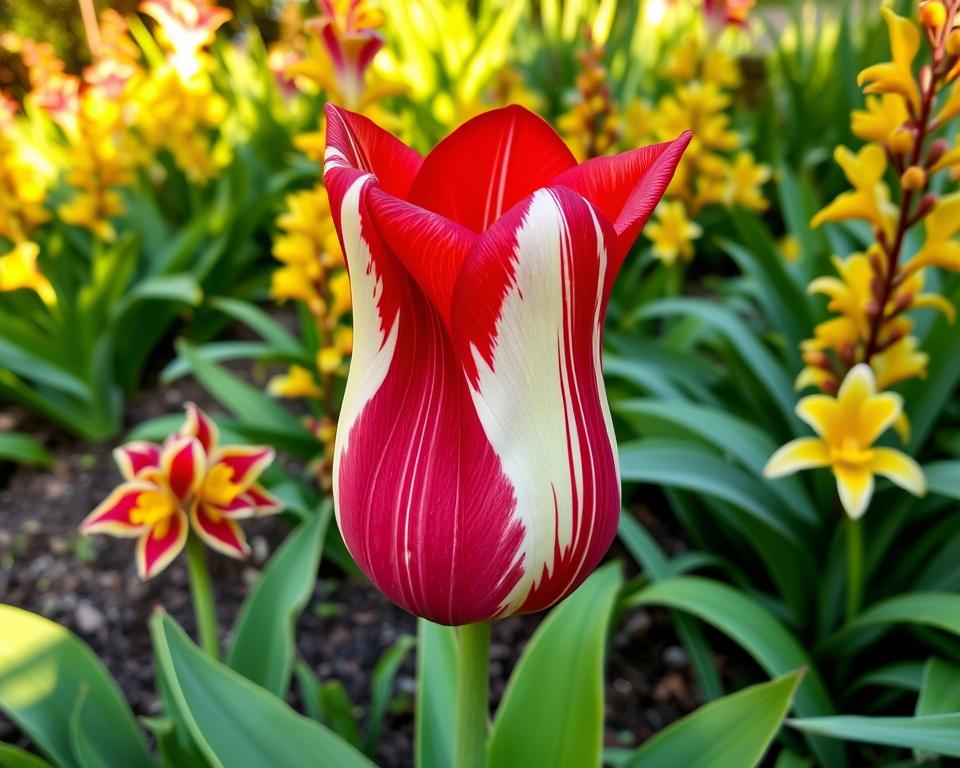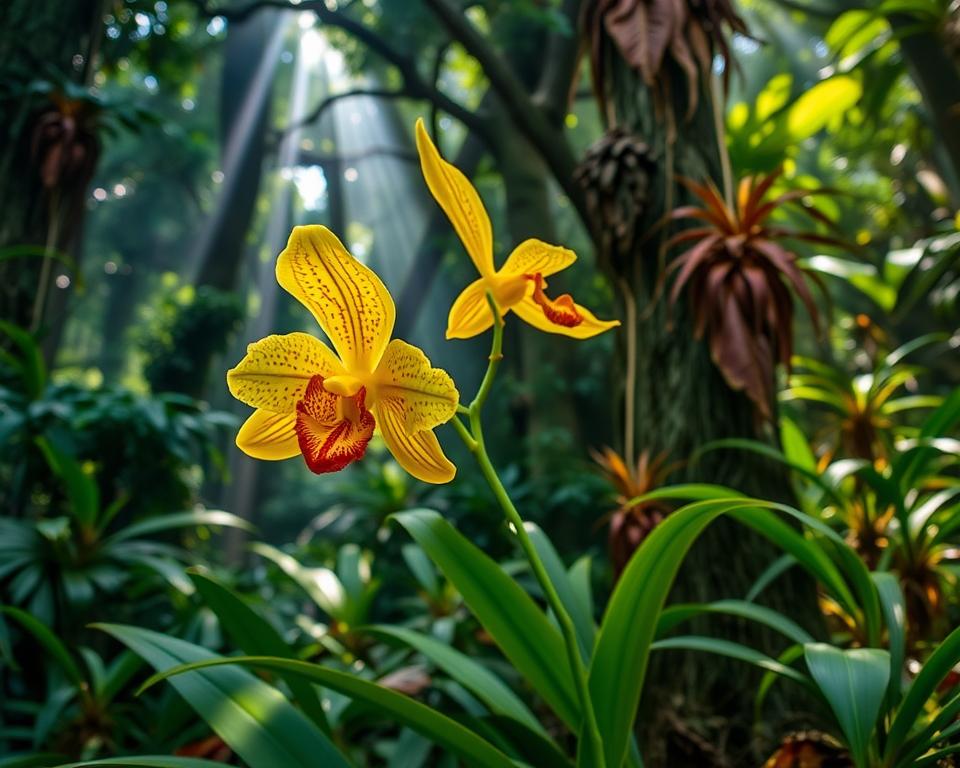Cultivating Moonflowers: Tips for a Stunning Garden

Moonflowers plant lovers are often amazed by their beauty and scent. With the right care, anyone can grow a stunning garden filled with these flowers.
Moonflowers add beauty and fragrance to any garden with their large, fragrant blooms and attractive leaves.
People love Moonflowers for their unique qualities. To grow these flowers well, gardeners need to know what they need. This includes picking the best spot, soil, and sunlight for them to thrive.
With proper care, gardeners can enjoy Moonflowers’ beauty and scent. Simple tips and advice can help anyone grow a beautiful Moonflower garden. Whether you’re new to gardening or experienced, growing Moonflowers is a rewarding hobby.
What Are Moonflowers?
Moonflowers are a type of flowering plant in the Ipomoea genus. They have large, showy flowers that bloom in the evening. These plants grow quickly and tolerate many soil types, making them ideal for gardeners.
There are several popular Moonflower varieties, like ‘Giant White’ and ‘Heavenly Blue’. They are easy to grow. With the right care, these plants can thrive in various conditions, appealing to gardeners of all levels.
Overview of Moonflower Characteristics
Moonflowers have large, fragrant flowers that bloom in the evening. They are vining plants that grow quickly. With proper care, they can add beauty to any garden.
Unique Features of Moonflowers
Moonflowers bloom in the evening, making them perfect for evening gardens. They also attract pollinators like bees and butterflies. This makes them a great choice for attracting wildlife to your garden.
Popular Moonflower Varieties
The ‘Giant White’ and ‘Heavenly Blue’ are popular Moonflower varieties. They have large, showy flowers and grow quickly. With the right care, these plants can thrive in different conditions, appealing to gardeners of all skill levels.
The Best Growing Conditions for Moonflowers
Moonflowers thrive in many conditions but do best with the right setup. Knowing their specific needs is key. With the right care, these flowers will bloom beautifully.
Moonflowers love well-draining soil rich in organic matter. They can grow in clay, loam, or sand but prefer slightly acidic to neutral soil. This is important for their health and growth.
Ideal Soil Types
The best soil for moonflowers is rich in compost and has a pH of 6.0 to 7.0. This soil gives them the nutrients they need. They also need full sun to partial shade, making them perfect for sunny spots.
Sunlight Requirements
Moonflowers need at least 6 hours of direct sunlight daily to bloom well. They can also handle partial shade. Knowing this helps gardeners create the best conditions for them.
| Soil Type | pH Level | Sunlight Requirements |
|---|---|---|
| Clay | 6.0-7.0 | Full sun to partial shade |
| Loam | 6.0-7.0 | Full sun to partial shade |
| Sand | 6.0-7.0 | Full sun to partial shade |
Climate Preferences
Moonflowers are quite hardy and can handle different temperatures. They love warm summers and mild winters. With the right care, they will add beauty to your garden and attract pollinators.
How to Plant Moonflowers
Planting moonflowers is easy and fun. You need to pick the right spot and time. Moonflowers love full sun to partial shade and need well-draining soil.
Choose a spot that’s big enough for the plants to grow. This will make your garden look amazing. You can start them indoors or directly in the garden.
Plant the seeds about 1/4 inch deep and 6-8 inches apart. Water well after planting. Keep the soil moist for a few weeks. With care, moonflowers will grow fast and bloom beautifully.
Choosing the Right Location
Think about how much sun your garden gets and the soil type. Moonflowers do best in well-draining soil and full sun to partial shade.
Planting Techniques
Sow the seeds about 1/4 inch deep and 6-8 inches apart. Water well after planting. Keep the soil moist for a few weeks.
Timing for Planting
Plant moonflowers in the spring after the last frost or in the fall, eight weeks before the first frost. This lets them grow and bloom, beautifying your garden.
| Planting Time | Location | Soil Type |
|---|---|---|
| Spring | Full sun to partial shade | Well-draining |
| Fall | Full sun to partial shade | Well-draining |
Caring for Moonflower Plants
Moonflower care is easy but needs some attention. To keep your moonflowers healthy, give them the right water and nutrients. Water them deeply once or twice a week, depending on the weather.
For fertilization, use a balanced fertilizer high in phosphorus. This helps with growth and flowering. You can also use a fertilizer for flowering plants. These tips will help you enjoy your moonflowers all season.

Managing pests and diseases is also key. Moonflowers can get pests like aphids and whiteflies, and diseases like powdery mildew. Use organic or chemical controls to manage these issues. Caring for your moonflowers will let you enjoy their beauty and fragrance all season.
Here is a summary of the key Moonflower care tips:
| Category | Recommendation |
|---|---|
| Watering | Water deeply once or twice a week |
| Fertilization | Use a balanced fertilizer high in phosphorus |
| Pest and Disease Management | Use organic or chemical controls as needed |
Follow these Moonflower care tips to keep your plants healthy. Always follow the instructions for fertilizers and pest control. Enjoy the beauty of your moonflowers.
Pruning and Training Moonflowers
Pruning and training are key to Moonflower care. By following Moonflower growing tips, gardeners can help their plants grow well and bloom beautifully. In the spring, after the last frost, cut back the stems to about 12 inches from the ground.
This helps new growth and more flowers. Train the plants to climb up trellises or supports. Use twine or clips to attach the stems and guide them upwards.
Pruning Techniques
When pruning moonflowers, use the right methods to avoid harm. Remove dead or damaged stems. Then, cut back the remaining stems to about 12 inches from the ground. This encourages new growth and more flowers.
Supporting Growth with Trellises
Trellises support moonflowers as they grow. They help keep the plants upright and encourage more flowers. Use twine or clips to attach the stems to the trellis. Follow these care tips for a healthy, blooming plant.
| Pruning Time | Pruning Technique | Trellis Support |
|---|---|---|
| Spring, after last frost | Remove dead or damaged stems, cut back remaining stems to 12 inches | Use twine or clips to attach stems to trellis |
Moonflower Companion Planting
Moonflowers can be paired with many plants to make a diverse and thriving garden. Companion planting can help with growth, more flowers, and pest control. By picking the right plants, you can make a stunning moonflower garden.
Herbs like basil and mint, and flowers like marigolds and zinnias, are great companions. They can be arranged to match the Moonflower garden design. This considers the size and growth of each plant.
Ideal Companion Plants
Herbs like basil and mint add fragrance and beauty to your garden. Flowers like marigolds and zinnias bring color and attract pollinators.
Benefits of Companion Planting
Companion planting offers many benefits. It can improve growth, increase flowers, and control pests. The right plants make your moonflower garden easier to care for.
Planning Your Garden Layout
When planning your garden, think about the size and growth of each plant. Also, consider their flowering times. This will help you create a stunning moonflower garden.
| Companion Plant | Benefits |
|---|---|
| Basil | Improves growth, repels pests |
| Mint | Repels pests, attracts pollinators |
| Marigolds | Repels nematodes, attracts pollinators |
| Zinnias | Attracts pollinators, adds color to the garden |
Moonflower Garden Design Ideas
Moonflowers can make any garden unique and beautiful. There are many ways to design a moonflower garden. You can create a stunning nighttime garden, add them to your landscape, or use them in containers.
Think about the look you want for your garden. Do you prefer a romantic or modern style? Moonflower garden design can match your taste.
Creating a Nighttime Garden
A nighttime garden is perfect for moonflowers, which bloom in the evening. Plant them in full sun to partial shade. Add other night-blooming flowers for a colorful and fragrant display. Start moonflower seeds indoors 4-6 weeks before the last frost and then move them outside.
Incorporating Moonflowers into Landscapes
Moonflowers can be used in many ways in your landscape. Plant them in groups for a dramatic effect or as a border for elegance. Train them to climb up trellises or supports for a vertical display. Make sure to plant them in well-draining soil and provide full sun to partial shade.
Harvesting Moonflower Seeds
As the moonflower blooming season ends, gardeners can start harvesting moonflower seeds for next year. This task is simple but needs patience and careful attention. Good moonflower care is key for a successful seed harvest.

When to Harvest Seeds
Moonflower seeds are ready in the fall, after the flowers have faded and the pods dried. It’s important to wait until the pods are completely dry. This ensures the seeds are mature and ready to harvest.
How to Collect Seeds
To collect moonflower seeds, cut off the seed pods. Then, remove the seeds from the pod. Store the seeds in a cool, dry spot, like a paper envelope or a glass jar, to keep them fresh.
Storing Moonflower Seeds
Storing moonflower seeds right is vital to keep them viable for planting later. By using the right storage methods and caring for the seeds, gardeners can save money. They also ensure a steady supply of seeds for years.
| Storage Method | Description |
|---|---|
| Paper Envelope | A cool, dry place to store seeds, such as a desk drawer or cupboard. |
| Glass Jar | An airtight container to store seeds, such as a mason jar or glass container with a tight-fitting lid. |
The Benefits of Moonflowers
Moonflowers are a great choice for gardens, offering many benefits. They attract pollinators like bees and butterflies, which are key for a healthy ecosystem. The Moonflower plant is especially appealing to nighttime pollinators, drawn by its scent and nectar.
Attracting Pollinators
The large, showy flowers of the moonflower are a favorite for pollinators. By adding moonflowers to your garden, you create a welcoming space. This attracts bees, butterflies, and hummingbirds, helping to support local biodiversity.
Nighttime Fragrance
Moonflowers have a strong, sweet fragrance that blooms at night. This scent attracts moths and bats, crucial for many plants’ reproduction. The Moonflower’s fragrance adds a magical touch to your garden.
Aesthetic Appeal
Moonflowers are not just functional; they’re also beautiful. Their large, showy flowers enhance any garden’s beauty. With their elegant flowers and delicate leaves, moonflowers are perfect for creating stunning garden arrangements.
Common Moonflower Problems
Moonflowers can face many problems like pests, diseases, and environmental issues. Knowing how to care for them can prevent these issues. This ensures they grow well and stay healthy.
Watch out for pests like aphids, whiteflies, and spider mites. These can harm leaves and flowers and spread disease. Regular checks and quick action can stop infestations. Also, the right sunlight and water help prevent pests.
Moonflowers can also get fungal diseases like powdery mildew and root rot. These diseases harm roots and leaves and stop the plant from getting water and nutrients. Good air circulation and not overwatering can prevent these diseases. Following care tips helps enjoy the beauty and scent of moonflowers.
Identifying Common Pests
It’s important to know common pests. Regular checks and quick action can stop problems before they get worse.
Solutions for Fungal Diseases
To fight fungal diseases, ensure good air flow and don’t overwater. Proper care and tips can prevent these diseases and keep the plant healthy.
Troubleshooting Environmental Issues
Dealing with drought and extreme temperatures is key in Moonflower care. Knowing these issues and how to prevent them helps keep moonflowers healthy.
| Common Problem | Solution |
|---|---|
| Pests (aphids, whiteflies, spider mites) | Regularly inspect the plant, use insecticidal soap or neem oil |
| Fungal diseases (powdery mildew, root rot) | Provide good air circulation, avoid overwatering, use fungicides |
| Environmental issues (drought, extreme temperatures) | Provide adequate water, protect from extreme temperatures |
Moonflower Uses Beyond the Garden
The Moonflower plant is more than just a pretty face in the garden. It’s also used in traditional medicine. People use its roots and leaves to treat fever and rheumatism. For more on the Moonflower, check out the observant gardener website.
It’s also a favorite in floral arrangements. The Moonflower’s big, fragrant flowers are perfect for bouquets. Plus, it’s used in weddings and festivals for its beauty and scent.
Moonflowers in Traditional Medicine
For centuries, the Moonflower has been used in traditional medicine. Its roots and leaves are known for their anti-inflammatory properties. This makes them useful for treating many health issues.
Fashioning Floral Arrangements
The Moonflower is a top pick for floral arrangements. Its large, fragrant flowers add elegance and beauty to any bouquet or arrangement.
Moonflowers in Cultural Practices
The Moonflower is also a key part of cultural practices. It’s often used in weddings and festivals for its beauty and scent. It’s a popular choice for decorations and arrangements at these events.
Conclusion: Enjoy the Beauty of Moonflowers
Moonflowers are a stunning addition to any garden. By following the care tips in this article, you can make sure they grow well. Whether you choose classic white or newer colors, they will bring joy and beauty.
Begin your moonflower adventure by picking the right spot. Make sure they get the right food and water. Then, watch as their beautiful flowers bloom in the evening. With a bit of care, your moonflowers will become a favorite in your garden, attracting bees and butterflies.
Keep exploring gardening by trying out other beautiful flowers. There are so many to discover, and it’s a fun journey. Happy planting!

